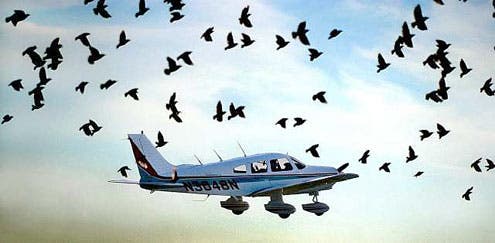Birds are experts at avoiding predators, quickly dodging out of harm’s way when felt threatened. Likewise, they’re fantastic at navigating through crammed environments like woods or packed urban dwellings. Even so, when faced with high-speed objects like cars, not to mention airplanes, the birds seem to make little effort to fly off a path that means most certain doom. Scientists have turned their attention to this enigma in hopes that they might develop the means to avoid bird impacts, for everybody’s sake. When a flock of birds hits an airplane’s engine, panic soon engulfs any seasoned pilot. Since 1988, 255 people have perished as a result birds impacting airplanes. So what did they found? Apparently, birds avoid predators or potentially deadly obstacles by judging how far away they’re from them, not by velocity. Past a certain velocity, birds don’t react anymore and remain where they are confident that they still have time to escape.

Most often than not, this reasoning makes them perish. It’s believed 80,000,000 birds are killed by cars in the U.S. alone, some of them endangered. Concerning airplanes, the latest incident happened in 2009 when US Airways Flight 1549 was forced to perform a crash landing straight in the in the Hudson River. The crash, widely referred to as the “Miracle on the Hudson,” resulted in no loss of life and only five minor injuries despite the freezing river – but it could have gone really, really bad.
So what’s up with geese? Are they just stupid or what? US researchers played videos of speeding trucks in front of cowbirds and then gauged their reaction times. When the trucks roamed at speeds under 60mph, the birds were very apt at escaping a collision course with the vehicle. Past this threshold, however, the birds were absolutely helpless. In fact, many would start flying only after the virtual track would have run them over. Oddly enough, a similar study was made last year on turkey vultures. This time, however, the researchers actually drove a real pickup truck directly at birds and tried to pick them off. The turkeys escaped the truck only at speeds below 55mph. I’m not sure if any birds were killed, but I’m guessing (hoping) not.

The mechanism seems to suggest that both cowbirds and turkey vultures (as well as most other birds) assess risks based on distance, not speed. When a potentially moving threat is at 100 feet away, the birds instinctively fly away. When this margin is covered under a second by a plane flying at several hundred miles per hour, hapless birds don’t stand a chance since it’s far below their reaction time.
The authors suggest in the paper published in the Proceedings of Royal Society B that airplane manufacturers install flashing lights to scare and ward off birds. As far as cars go, the scientists recommend we slow down when driving through bird crowded regions, especially near conservation sites where there’s always the risk of killing an endangered specimen.






